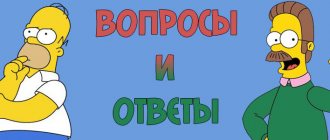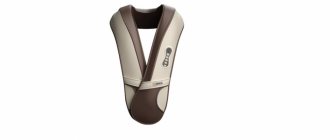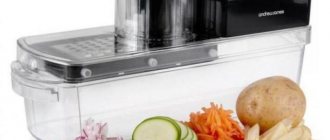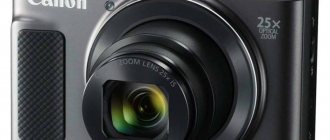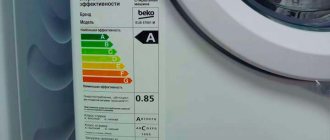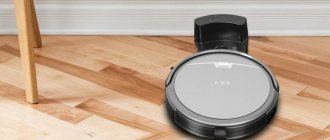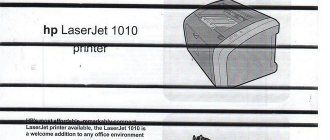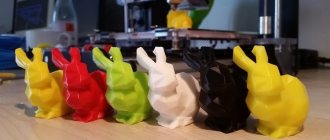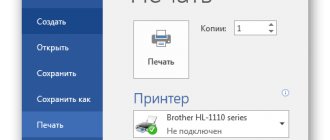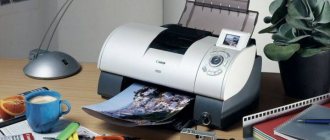Updated: 02/27/2021 19:45:52
Expert: Vladislav Samoshkin
*Review of the best according to the editors of expertology.ru. About the selection criteria. This material is subjective in nature, does not constitute advertising and does not serve as a purchase guide. Before purchasing, consultation with a specialist is required.
Plotters are a special subtype of printing devices that are used to produce a wide variety of products - from visual advertising and large-format engineering diagrams to T-shirts with bright prints. As such devices become more affordable in price, maintenance and operation, more and more operational printing enterprises are acquiring them. Our rating review today is dedicated to the best plotters, according to Expertology experts, in four different categories - inkjet, solvent, textile and ultraviolet. First, let’s go through the basic criteria for choosing a plotter suitable for certain purposes.
How to choose a plotter
Initially, the term “plotter” meant plotters - pen tablet devices that literally draw graphs and diagrams with great accuracy. As inkjet printing technology improved and the range of devices expanded, plotters began to be called any large-format printers (at least A2) with or even without an automatic cutting function. Obviously, there are no household large-format printers-plotters - all this is professional equipment for use for commercial purposes - in operational printing enterprises, large advertising agencies, design bureaus, and copy centers.
Purpose
The importance of certain characteristics and the presence of certain functions is primarily determined by the purpose of the purchased plotter. So, for example, if it is expected that the lion’s share of prints will be photo wallpapers, banners, posters, billboards and other outdoor items, one type of device will do; if you mainly plan to print complex infographics, vector images with small details, engineering drawings, you need to look for a plotter with just such a specialization.
In any case, there is a generally accepted conditional division of large-format printers-plotters into three groups: drawing (CAD/AEC), topographic (GIS) and for artistic printing. For the first two categories, the accuracy and fineness of the lines are important, so the maximum resolution will be in the foreground (optimally in most cases 2400x1200 dpi) and the minimum line thickness - no more than 0.01 mm.
All of the above points should be clarified at the point of sale and require detailed explanation and detailed consultation.
Media format and type
Media width size, or simply format, is the key characteristic by which printers are classified as wide-format. It is generally accepted that these models are capable of printing on A2 or larger formats. A big advantage is the possibility of roll feeding, since paper and other media in rolls are much cheaper than sheet media, all other things being equal. The maximum format directly affects the dimensions of the device and its cost.
Acceptable media type can vary significantly from model to model and directly depends on the printing technology and ink type. For example, most plotters print without problems on matte and glossy paper of various densities; slightly less are able to print on polymer films and even less on textiles. There are no completely universal devices in this price category on the market, and future specialization must be carefully thought out in advance.
Some models of specialized printers are also considered plotters if they use the appropriate technologies - cutting, roll feeding, printing on special media, etc. In the latter case, there may be even a smaller format - in our rating we will consider one such plotter of a slightly smaller format than A2, capable of printing on textiles, including ready-made T-shirts.
Ink type and printing technology
Inkjet printers, including large-format ones, are distinguished by the printing principle - thermal or piezoelectric. The difference between them is as follows. Piezoelectric ones, for the most part, provide significantly better quality than thermal inkjet ones, but at the same time they are inferior to them in terms of printing speed and, on average, are significantly more expensive. Thermal inkjet, on the contrary, is cheaper, faster, but other things being equal (resolution, number of basic colors used, use of innovations) are inferior in image quality to piezoelectric ones.
An extremely important point is the type of ink used. Conventional water-soluble or pigment inks are the simplest and most affordable option, but they are also the least resistant to environmental factors, and such inks can be reliably applied almost exclusively to paper. If the printer uses solvent ink, this automatically means that the image will stick firmly even on PVC media, it will not be washed off by rain or faded in the sun. Sublimation ink is used for efficient and high-quality printing on textiles. A separate and very expensive type of ink is UV ink, which hardens when irradiated with an ultraviolet lamp or LEDs. This results in a fundamentally different character of the printed image.
Electronics, connections and additional functions
When printing large raster images in high resolution, the plotter has to process significant amounts of data. In order for the device to cope with such processing without failures and interruptions in the printing process that are detrimental to the quality, it is desirable that it be equipped with a sufficient amount of RAM for the range of tasks required by the buyer, a powerful processor and a hard drive. Such a complete set is not always available in the basic configurations of plotters, so at the point of sale you should definitely ask what tasks this or that configuration can handle and whether it can be expanded.
In some cases, it makes sense to have additional functions and capabilities in the plotter - the function of printing on photo paper with sheet feeding from a separate tray, borderless printing, etc.
It is worth asking in advance about the acceptable methods of connecting to the device. Some models are limited only to the local network interface - RJ-45, others, in addition, allow you to connect the device directly to a PC via USB, and some allow you to interact with the plotter via Wi-Fi and effectively use cloud services.
cutting
An important function of the plotter is the presence of automatic cutting. At a minimum, it is necessary to at least have a knife to cut the roll media upon completion of printing of each block. A more advanced option is the contour cutting function. Its presence significantly expands the potential range of products produced by the plotter - stickers, curly flyers, cardboard souvenirs, etc. When choosing a plotter with contour cutting, you should pay attention to two main parameters - cutting accuracy and pen pressure. The first determines what materials and what density the device can qualitatively cut along the contour, and the second determines how small parts the plotter can cut. “Aerobatics” - the presence of an optical positioning sensor - if available, the plotter can cut along contours and graphic marks, even if the workpiece itself was printed on another device.
Printing and cutting plotters
Printing and cutting plotters (plotters-cutters)
— devices that combine the functions of a roll printing plotter and a roll cutting plotter in a single housing.
Depending on the type of ink used, printing and cutting plotters are:
- UV plotters and cutters are based on UV printers.
- Solvent plotter-cutters are based on solvent printers.
For some types of production, this combination of functions is very convenient, for example, when printing a run of stickers - a hybrid plotter will be able to print on the surface of self-adhesive paper in the first run, and in the second run, cut a roll into a run of stickers of a certain shape, without changing the roll in the plotter.
On the other hand, using two separate plotters gives you more flexibility. Firstly, it allows you to perform two different jobs in parallel (printing on a solvent plotter and cutting on a cutting plotter), which can significantly increase productivity. Secondly, if one of the devices fails, the second will continue to work, which also reduces costs and allows production to be continued at least partially.
Rating of the best plotters
| Nomination | place | Name of product | price |
| The best inkjet plotters | 1 | HP DesignJet Z9+ 24″ Postscript (W3Z71A) | 244 986 ₽ |
| 2 | Canon imagePROGRAF iPF685 | 154 169 ₽ | |
| 3 | Epson SureColor SC-T3400N | 148 000 ₽ | |
| The best solvent plotters | 1 | Roland VersaStudio BN-20 | 556 224 ₽ |
| 2 | Mimaki JV150-160 | 725 872 ₽ | |
| The best textile plotters | 1 | Mimaki TS300P-1800 | 1 787 860 ₽ |
| 2 | Epson SureColor SC-F2000 | 850 820 ₽ | |
| Best UV plotters | 1 | Mimaki JFX200-2531 | 7 731 000 ₽ |
| 2 | Mimaki UJF-3042 MkII | 1 390 559 ₽ |
How to choose a cutting plotter: types and applications
Cutting plotter (cutter)
— a machine for precise cutting of stencils from various materials.
In the field of decoration, advertising and design, such equipment is extremely popular. It is used to decorate shop windows, make outdoor advertising, signs, etc. The machine allows you to cut patterns, letters, images from roll and sheet materials. Types of cutters The roll cutting plotter
is considered a classic among its analogues. Features a small work surface. The rolled material is fed into the cutting area by a special mechanism. A sheet of any length can pass through the equipment, but the machine is limited in the width of the material. A roll plotter is one of the most affordable and convenient machines. The simple operating system and compactness have made this type of cutter the most popular. It is designed to work with roll materials - film, paper, tracing paper. Perfect for creating stickers, postcards, flyers and other promotional materials. For working with large format media, a roll cutting plotter with a cutting area of up to 1.9 m will be suitable. For small formats, a cutting area of up to 0.4 m will be sufficient.
Flatbed cutting plotter
has a limited work surface in the form of a table.
The material to be processed is placed on it. Cutting occurs with knives or lasers on a moving carriage. Such equipment will come in handy when working with heavy sheet materials. Due to workspace limitations, the flatbed cutting plotter is less common than other cutters. Print-cut plotters
are also known as hybrid plotters or cutter plotters. Such a machine combines the functions of image printing and slicing under one body. The operating mechanism is the same as that of a roll plotter + print option. Of course, this is a convenient machine for workers in the advertising industry. He saves time and is able to apply an image in the first pass, and cut it in the second.
If you are looking for equipment with contour/regular cutting or perforating functions, then Challenger can offer you the best prices. Our specialists will help you choose a machine that meets the requirements of your production. To make using the equipment comfortable, the company provides detailed instructions in Russian. Managers from service centers in Moscow and Novosibirsk are ready to answer all questions around the clock.
The best inkjet plotters
Let us first consider printers-plotters in the most inexpensive price category. Their affordability is explained by the use of the simplest printing technology - inkjet (thermal or piezoelectric) using conventional water-soluble or pigment inks. Our experts suggest paying attention to three models from different manufacturers - Hewlett-Packard, Canon and Epson. All three examples are designed for a maximum sheet format of A1, and also support printing on roll media. The type of media can vary - from matte paper to polymer film, and it is advisable to clarify this at the point of sale.
HP DesignJet Z9+ 24″ Postscript (W3Z71A)
Rating: 4.9
The first selection of the ranking of the best plotters opens with a wide-format inkjet printer from the famous American company Hewlett-Packard. This is the most multifunctional and expensive device among the three presented large-format inkjet plotters.
The plotter is designed for floor placement - the printing module is placed on a special mobile cart on wheels. The overall dimensions of the entire structure are 1293x998x695 mm, weight is 72 kg net and 102 kg in packaging. Packaging dimensions: 1440 x 766 x 718 mm.
To operate, the device requires up to 100 W of electrical power, in passive mode – up to 32 W. The nominal noise level during operation should not exceed 45 dB. When idle, the printer is also slightly noisy – up to 33 dB. The control panel is equipped with a color touch display.
Color printing for this model is carried out using thermal inkjet technology. As many as nine cartridges of 300 ml each with pigment ink and one more with auxiliary composition take part in the formation of a high-quality image: magenta, yellow, cyan, chromatic red, photographic black, matte black, chromatic green, chromatic blue, gray, gloss enhancer. The maximum resolution is 2400×1200, the minimum drop volume is 6 pl. The accuracy of the lines is within an error of 0.1%. The minimum line width is 0.02 mm.
This model provides several possibilities for using media. Thus, the minimum acceptable sheet format is 210 x 279 mm, the maximum is 610 x 1676 mm. Sheets can be fed from above or from behind. Rear feed is intended primarily for the heaviest and hardest media (the plotter is capable of printing 500 grams per square meter on cardboard, the minimum paper weight is 80 g/m2). Another option is roll media with a width of 279 to 610 mm. In this case, another part of the model becomes important - an automatic paper cutter. For neat placement of output prints, there is a special catch basket under the printer in the space of the trolley stand. Maximum print productivity reaches 55.7 square meters per hour.
Against the backdrop of the outstanding characteristics of printing itself, this model’s electronic hardware commands respect. So, there is as much as 4GB of RAM installed here - a volume comparable to full-fledged personal computers and a 500 GB hard drive, in which 128 GB is automatically allocated to virtual memory to expand the RAM. Thus, the model developers did everything to ensure that the plotter did not “slow down” even when processing the most voluminous data arrays for printing large-format images in high resolution.
The plotter is connected directly to the local network via a wire with a standard RJ-45 twisted pair interface. There are no other connection methods, such as Wi-Fi, but this should in no way be considered a disadvantage; it is a completely reasonable feature of professional-grade commercial equipment.
Additional features and capabilities: web interface; PostScript support; direct printing; integrated Adobe PDF Print Engine. Branded drivers are written for operating systems Windows, Mac OS, iOS, Android.
The printer delivery set includes: a plotter, a set of test cartridges, a mobile trolley stand; basket-catcher for finished prints; spindle; instructions; setup instruction poster; power cable; print heads. In addition to the above, the manufacturer recommends a set of original HP software for different systems: Applications Center, Color Center, Click, Partner Link Pay-per-use, PrintOS, Web JetAdmin.
Advantages
- professional level of the device;
- 9 pigment ink cartridges;
- gloss enhancer in the 10th cartridge;
- printing photos;
- cloud printing support;
- automatic cutter;
- mobile trolley stand.
Flaws
- no obvious shortcomings or systematic negative reviews were identified.
Canon imagePROGRAF iPF685
Rating: 4.8
The second number in the first selection of the rating we will consider a large-format printer from the famous Japanese brand Canon. This device is less functional and generally simpler than the previous model, but is still capable of meeting all or almost all of the production needs of an operational printing enterprise. And with all this, this model is cheaper than the previous one by an average of 100 thousand rubles.
The design of this model is fundamentally identical to the previous one: the functional module is placed on a mobile stand-cart with wheels; in the space of the cart under the printer there is a basket-catcher for finished prints. Dimensions of the entire structure are 997x1062x1100 mm, net weight is 56.9 kg, rated operating voltage is 140 W, operating noise is up to 47 dB, idle noise is 35 dB.
In this plotter, the formation of a color image is already carried out on the basis of a standard four-color model with the only additional ink - matte black. Each ink has a separate tank with two capacity options - 130 or 300 ml. The minimum drop volume is 4 pl. Black ink is pigment ink, color ink is water-soluble. Maximum resolution: 2400×1200 dpi. There is a photo printing function and borderless printing. Estimated print speed based on one D-size color print (24×36 inches) is 28 seconds.
We should also highlight the elegant solution of the developers of this plotter regarding the use of ink. There are two options for ink tank capacities - 130 or 300 ml, and you can decide for yourself which volume is best based on the most likely workload. In addition, the possibility of “hot” replacement of cartridges is implemented here due to the presence of intermediate reservoirs between each cartridge and the print head.
Parameters of recommended and acceptable consumables: sheet width – from 203.2 to 914 mm; roll width – from 254 to 610 mm; media thickness – not less than 0.07 and not more than 0.8 mm; external diameter of the roll – up to 150 mm; maximum print length is 18 m.
The electronics in this model are already more modest than in the previous one, but they fully cope with their direct tasks. The installed RAM is 256 MB, and the hard drive is not too far behind the solution described above - 320 GB. You can connect to the device not only via a local network via the RJ-45 interface, but also directly from a PC via USB 2.0. The standard set of drivers supports Windows and Mac OS systems. PostScript is not supported.
Advantages
- hot cartridge replacement;
- quality of CAD graphic materials;
- convenient work in cloud environments;
- intuitive software for direct printing and sharing;
- accounting tools.
Flaws
- not detected.
Epson SureColor SC-T3400N
Rating: 4.7
The top three inkjet devices in the ranking of the best plotters according to Expertology are completed by a model from the SureColor line from Epson. This is already a desktop form factor, although if necessary, you can easily order the same trolley stand as the two above-mentioned models. The price of the printer is comparable to the previous Canon model.
Plotter dimensions - 1080x585x668 mm, net weight - 49 kg. In operation, it consumes significantly less energy than either of the two models described above - 38 W under load and no more than 13 W at idle. Noise during operation does not exceed 50 dB. The control panel is equipped with a 3.4-inch color display. Printing technology: piezoelectric inkjet.
Color printing here is based strictly on the 4-color standard model without additional ink or auxiliary compounds. Accordingly, four cartridges are used. The minimum drop volume is 4 pl. The maximum resolution is 2400×1200. There is a function for photo printing and borderless printing. Cartridge volume – 110 or 350 ml. Printing speed – 25 seconds per A1 print. The first print comes out after 25 seconds.
This plotter is designed for printing on paper as media only. The permissible thickness - no less than 0.05 mm and no more than 0.3 mm - applies to both sheet and roll media. The maximum roll diameter is 170 mm.
RAM is installed here in the amount of 1GB, connection is possible via a local network, USB 3.0, as well as via a wireless Wi-Fi channel of the 802.11n standard. Direct printing and AirPrint are supported. There is no PostScript support. Official drivers are for operating systems of the Windows, Mac OS and iOS families.
Advantages
- relatively affordable price;
- print speed;
- available consumables;
- low power consumption.
- wireless connection.
Flaws
- no obvious deficiencies were found.
Main characteristics of the cutting plotter
The choice of cutting plotter depends on the list of work that will be performed on it. This is exactly what needs to be taken into account when selecting a device. The main distinctive features of plotters are:
- Format of cutting materials;
- Cutting accuracy;
- Optical positioning;
- Knife pressure;
- Speed of cutting materials.
Let's look at each of these parameters in more detail.
Material cutting width
Material cutting width
usually limited to 1000 mm. This is enough for the production of basic types of advertising materials, but there is a need to use larger format plotters. But practice shows that in most cases a plotter with a working area of 500–720 mm is sufficient for work.
Cutting accuracy
The next important parameter that must be taken into account when choosing a cutting plotter is cutting accuracy
. If the work requires cutting out small parts, a plotter is needed with great cutting accuracy, which significantly increases its cost.
Optical positioning
Another important parameter of a cutting plotter is optical positioning
. Optical positioning characterizes the presence of an optical sensor on the plotter, which allows you to detect optical marks on the printed layout for cutting. This will allow you to cut out a part of any complexity, previously printed on a printer, along the specified contour. For example, the same circulation of stickers - if a roll with a printed circulation of stickers is installed in the plotter, which now needs to be cut, the plotter needs to “snap” to the coordinate grid using optical marks so that it can accurately cut out even complex contour shapes, precisely repeating the curves of the printed image .
If exact alignment of coordinates between the material and the contour cut out on it is not required (for example, cutting letters from Oracal color film), there is no need for an optical sensor.
Knife pressure
Knife pressure
- a parameter that must be taken into account when choosing a cutting plotter. This parameter determines what density of material we can process. If we plan to cut materials from photo paper, self-adhesive and thermal film, it is enough for us that the knife pressure parameter is equal to 350 g. But if we plan to cut, for example, magnetic vinyl, this is not enough. In this case, the pressure on the knife should be at least 400–500 g.
Material cutting speed
Another equally important characteristic of the plotter is the speed of cutting materials.
. It is important at what maximum speed the cutter cuts without loss of quality. If there is no need for urgent cuts, then it makes sense to choose a machine with a lower speed, which will save money.
Cutting plotter motor type
The blade in a cutting plotter is driven by a motor, which can be either a stepper motor (mechanical) or a digital servo motor (servo motor).
A mechanical stepper motor moves the knife in increments. Due to old and proven technology, such cutting machines show high and stable productivity and also have a low cost. But cutting plotters with a stepper motor also have disadvantages - they are noisy and do not have high cutting accuracy. This technology is not intended for cutting smooth contours or circles.
To solve more complex problems (for example, cutting out contour shapes), plotters with a digital servo drive were created. The servo motor drives the cutting plotter head using a digital encoder that receives commands from the computer. Cutting plotters with a servo motor can cut out both large objects and miniature characters (from 3 mm), without losing the accuracy of the cutting even when producing large volumes, but such devices also cost much more.
In addition to the above parameters, the cutting plotter has other parameters. These include an LCD display, a holder for roll materials, a network pointer, a cross cutter, a basket for materials, a tool glove compartment and other auxiliary tools.
At the moment, there are many companies that produce cutting plotters. Among this set, it is worth highlighting such manufacturers as Mimaki, Roland, Graphtec, GCC, Silhouette and others.
So, no matter what cutting plotter you choose, you must be guided by the purposes and volumes for which it will be used. For small volumes, you should not buy a device that is too expensive, since it will not perform all its functions. But at the same time, with high volumes of work, it is worth approaching the purchase of a cutting plotter in more detail.
You can always get detailed information, as well as select and buy a cutting plotter for your tasks on our website or by contacting a specialist from the sales department.
The best solvent plotters
The second group of plotters in our rating are devices that use a special type of ink for printing - solvent. They are based on the solvent itself - an organic solvent, which is a mixture of light hydrocarbons. Being chemically aggressive, the solvent in the ink composition, when it gets onto the image carrier during printing, partially dissolves the top layer, penetrates deeply and firmly into the surface, and then quickly evaporates. The resulting image is resistant to moisture, ultraviolet rays and a number of other environmental factors. This makes inkjet printing possible even on PVC-containing media with reliable image retention. Solvent ink is used only in printers with a piezoelectric printing principle.
Currently, the most prominent manufacturers of solvent printers are the Japanese companies Mimaki and Roland. It is their products that Expertology specialists recommend, and we will look at the two most successful models.
Roland VersaStudio BN-20
Rating: 4.9
First we will describe a plotter that is “simpler” and cheaper. This is a representative of the bright VersaStudio line from Roland. Its cost on the Russian market is about half a million rubles, depending on the point of sale and the specific batch.
The dimensions of the device are largely dictated by the maximum possible media format - A1, and amount to 995x291x585 mm. Net weight - 35 kg. These parameters are almost the maximum limit for the possibility of desktop installation, and Roland engineers managed to implement just such a form factor. During operation, the printer consumes up to 90 W of electrical power and no more than 5.5 W when idle. Noise during operation should nominally not exceed 62 dB; when idle, the unit is also not silent - 42 dB.
The plotter produces full-color images based on the standard CMYK model with an additional fifth Mt cartridge to reproduce the metallic silver shade. The maximum resolution is 1440×1440. There is a photo printing function. Recommended inks are Roland ECO-SOL MAX or FPG Aqueous.
This device can use the following types of media: paper, photo paper, photo wallpaper, polymer film, poster paper, vinyl mesh, fresco and eco-fresco, various materials for banners. Structurally, the model is optimized for roll feeding, the maximum roll thickness in diameter is 150 mm and the weight is no more than 6 kg. Acceptable media width is from 150 to 515 mm. Maximum thickness – 1 mm with backing.
One of the important aspects of the functionality of this model is the page-by-page and contour cutting function. The permissible cutting media thickness is 0.4 mm with a backing or 0.22 mm without using a backing. Cutting width – up to 480 mm. Speed - 150 mm/s.
The plotter is connected to a PC via a USB 2.0 interface. Standard drivers only support Windows operating systems. PostScript is not supported.
The delivery set includes a plotter, power cords and USB connections, a knife and holder, VersaWorks software, and instructions.
Advantages
- fifth color – silver paint;
- automatic contour cutting;
- a high resolution;
- Consistently high quality when using original ink.
Flaws
- not detected.
Mimaki JV150-160
Rating: 4.8
And the second solvent plotter in our rating is a model twice as large in format and much more functional. The price, of course, is more expensive than the Roland described above, but not by several times, but by 50-60% on average at points of sale. You need to understand that despite the impressive price, this series is considered a budget alternative to the Mimaki JV300.
The physical parameters themselves speak of the professional, almost industrial nature of the device: dimensions - 2775x1392x700 mm, net weight - 185 kg. Energy consumption is comparable to fairly powerful household heaters - 1920 W, but in the context of capabilities and performance, such costs are completely justified - they allow you to quickly and efficiently print on A0 format media.
The maximum resolution in which the plotter is capable of printing is 1440×1440 dpi. Here, for a complete understanding, you need to take into account a number of important points that the device developers have provided for in its functionality. For example, it is possible to install and use two options for sets of cartridges by color: 4 colors of the standard CMYK model or 6 colors, where in addition to the 4 main ones, light cyan and light magenta are also used. The functionality allows you to add orange and light black. In addition, a number of patented Mimaki innovations are implemented here, such as the Advanced Pass System (simulating gradation printing to eliminate the appearance of non-pass inconsistencies), a three-stage intelligent media heating system, compensation for faulty nozzles and other features that allow you to obtain a picture of incredible quality and realistic color reproduction.
The plotter supports printing on paper and films, including roll feed. The maximum permissible media thickness is 1 mm, width is 1610 mm. Printing speed reaches 56.2 m2. at one o'clock. When using a standard four-color model, the device can operate from paired cartridges - if one is empty, the plotter automatically switches to another cartridge of the same color, and the empty one can be replaced without stopping printing. Optionally, a CISS with large reservoirs of several liters for each color can be installed.
You can connect to the plotter via a network via RJ-45 or directly to a PC via USB 2.0. Official drivers have been released for operating systems of the Windows family. PostScript is not supported.
In general, the plotter’s capabilities allow you to produce a wide variety of graphic products: high-quality outdoor advertising, art reproductions, exhibition graphics, interior decor, car styling elements, POS materials and much more.
Advantages
- hot replacement of cartridges;
- automatic paper cutter;
- CISS optional;
- innovative technologies and approaches to maximize print quality;
- performance;
- professional level at a relatively affordable price.
Flaws
- no contour cutting.
Why do you need a cutting plotter?
Modern cutting plotters (cutters) are capable of working with a large number of different materials - thermal film, photographic paper, designer cardboard, magnetic vinyl and other types of film. The choice of a specific material largely determines the size of the plotter and its cost. For example, if you decide to start producing stickers, postcards, or plan to work with photographs at home, you can choose an inexpensive model with a working area (material width) of up to 300-400 mm to suit these needs.
For large-format materials, it is necessary to choose plotters with an increased cutting area - up to 1900 mm. Such models will allow you to create wide canvases, for example, vinyl car stickers or advertising banners.
The best textile plotters
The third category of devices in our rating are plotters, structurally and conceptually oriented for printing on a variety of textile media. Such printers use a special type of ink - dispersion or sublimation; a variety of techniques and technologies are used to make the image realistic and at the same time resistant to environmental factors - solar ultraviolet radiation, moisture, negative temperatures and their changes. Using textile printers they produce: flags, pennants, standards and other symbols; tablecloths and bed linen; curtains and upholstery fabric; stretch ceiling; outdoor advertising; clothes for sports competitions, promotions, for everyday wear (T-shirts with prints); various scenery.
Mimaki TS300P-1800
Rating: 4.9
First, let's look at a powerful professional wide-format model produced by the specialized Japanese company Mimaki. This is a real record holder in terms of the maximum permissible media format.
The dimensions of the device in no way leave a chance for office installation - 3200x1857x850 mm. The unit also weighs more than decently - 213 kg and consumes 1.92 kW of power in operation. The delivery set includes a stand for floor installation. Connection – via USB 2.0 or Ethernet.
The maximum media format for this model even exceeds A0 dimensions - the printing width is 1940 mm. Sheet feeding is not provided - only roll feeding, and this is more than rational with such a huge format. The maximum permissible roll diameter is 250 mm, the maximum weight is 40 kg. For this model, it is permissible to use not only textiles as a carrier, but also polyester and various types of special paper - transfer, sublimation, for heat presses. Borderless printing is not possible. There is an automatic rewinder for smooth transition from roll to roll and an automatic paper cutter. The maximum media thickness is 1 mm.
The plotter uses piezoelectric printing technology with sublimation ink. The maximum resolution is 1040 x 1040. In draft mode, the print speed reaches 115 sq. meters per hour. It is possible to use two color schemes - 4 basic colors of Mimaki branded inks - blue, magenta, yellow. black; 6 basic colors - light blue and light purple are added to the four listed. The plotter “by default” is equipped with a proprietary CISS Mimaki Bulk Ink System 3, where a 2-liter reservoir is allocated for each ink color.
In this model, Mimaki engineers have implemented a number of improvements and innovations to maximize print quality and stability, minimize the likelihood of defects, simplify the operator’s work, etc. For example, an innovative vacuum material tension system has been successfully introduced here to prevent media waviness and unwanted direct contact with the print head. Automatic rewinding ensures uniform supply of media from the roll. Patented MAPS4 print control technology eliminates spot color bending and unevenness by blurring the edges of the pass like a gradient. It also implements an improved technology for controlling the voltage wave on the piezomembrane of the head - the drops are obtained in an ideal spherical shape.
Advantages
- print width;
- printing not only on textiles, but also on paper;
- speed;
- exceptional quality;
- effective use of innovations.
Flaws
- No noticeable shortcomings or systematic user complaints were found.
Epson SureColor SC-F2000
Rating: 4.8
Now, as part of the rating of the best plotters according to Expertology, we will consider a model for a highly specialized purpose - for creating prints on T-shirts and media of similar form factor. Our experts considered it necessary to pay special attention to this type of printer, since the business model of making money on T-shirts with prints was and remains relevant and in demand.
The printer prints on fabric or ready-made T-shirts. Print field width – 406 mm. This is slightly smaller than A2 format, but there are modifications of the same model with a print field expanded to 420 mm. With this format, the device dimensions are 985x490x1425 mm, net weight is 82 kg. These parameters allow you to install the plotter on a table. To operate, it needs to be connected to an electrical outlet with a consumption of up to 52 W. The noise level is low, comparable to simple household printers - up to 41 dB.
The plotter uses a piezoelectric inkjet printing principle using special ink. You can use two options for a set of ink cartridges: 4 colors in accordance with the standard CMYK model or 5 colors, where the additional color is white. The purpose of white is obvious - for full reproduction of images on dark backgrounds. The volume of ink tanks can also be different - 250 or 600 ml to choose from, depending on the intensity of use of the plotter.
The quality of printing is determined directly by the technical resolution - 1440×1440 dpi and the use of special innovative techniques, which are discussed below. The minimum drop volume is 21 pl. This is several times and tens of times more than in the case of other types of plotters, but for printing on cotton or any other T-shirt base, a smaller volume will not provide the required quality. Printing speeds are up to 88 seconds per T-shirt, depending on resolution.
The printer has quite a lot of RAM - 512 MB. There are two connection methods: local network via RJ-45 or USB 2.0 interface directly to a PC. Branded drivers are released only for Windows operating systems. PostScript is not supported.
It is worth highlighting a number of important advantages of this model: the ability to print on 100 percent cotton or mixed fabrics (minimum cotton content - 50%); media thickness – up to 25 mm – a special printing table is used, which can even be purchased separately if desired; the model has received Oeko-Tex 100 (Product Class 1) certification, guaranteeing safety for all ages - from adults to infants; minimization of defects thanks to the ink circulation system and effective automatic cleaning of the piezo head; ultra-resistant Epson UltraChrome DG dye inks do not fade, do not crack, do not wear out, and are not afraid of washing; do not create a feeling of rigidity and “sharp corners” when wearing clothes.
Advantages
- printing on cotton, synthetics and mixed fabrics;
- large permissible media thickness;
- environmentally friendly, child-safe dyes;
- convenient and understandable software.
Flaws
- very expensive consumables.
SubliMaster
The next article on the site is devoted to choosing a cutting plotter - a rather complex and not cheap device. Therefore, you need to approach his choice thoroughly. What are we going to do now? Sooner or later, no matter how well your sublimation business goes, you will think about expanding your range. Sublimation printing on T-shirts, for all its quality, will limit you in its capabilities - light colors and the exclusively synthetic composition of T-shirts will significantly narrow the circle of your customers. That's when you think about film thermal transfer - a transfer method where the composition of the fabric, its color and density do not matter. You already have a heat press, buying thermal transfer films is not a problem, all that remains is to purchase a cutting plotter. It is sometimes also called a cutter, from the English “cutter”, which translates as cutter, cutting machine.
There are plotters - cutting, printing and cutting-printing at the same time. We are now exclusively interested in the former, so the main task for us is cutting out various patterns and text from thermal transfer film.
Cutting plotters are divided into flatbed, roll and laser.
A flatbed plotter is a flat table on which the material to be cut is fixed. A carriage with a knife moves above the table.
A laser plotter is the same as a flatbed plotter, but instead of a knife it has a laser. This type of plotter is often used in the advertising business, for example, for cutting plexiglass.
A roll plotter is a device capable of cutting large roll materials. For cutting thermal film, this is exactly what we need.
So, we have decided on the type of plotter. Now it’s worth considering some other features and properties of cutting plotters. As I already said, this device is not cheap, so it’s worth weighing all the pros and cons so that you don’t later regret wasted money or, conversely, buying a plotter without the functions you need.
1. The first thing you should think about is the size of the plotter, or rather its cutting width. While plotters have virtually no restrictions in length when cutting film, in width we are limited by its dimensions. If you are sure that the maximum size of the thermal applications you apply will not exceed the A4 format, then you just need to purchase a plotter with a cut of 20 - 22 cm. You will save money, and such a device takes up minimal space on the table.
But still, A4 is not enough for T-shirts. On large-sized T-shirts, such an image looks a little small. I advise you to purchase a plotter of at least A3 format, that is, with a cutting width of 30 cm or more. You won’t overpay much, but your capabilities will increase many times over.
When choosing a plotter, do not forget about the size of the platen of your heat press. Still, in a small press it will be difficult for you to translate a large image.
2. The second important indicator is the presence (or absence) of a positioning sensor. This is a very useful feature that allows your plotter to cut images exactly along the contour. The positioning sensor is the “eye” of the plotter, capable of accurately determining the edges of the printed image using special marks. This function is very useful when making badges, magnets, and also when making thermal transfers on T-shirts. Watch the video showing how to make a thermal transfer on Forever paper. It's in English, but everything is intuitive. In this case, Forever Subli-Dark paper was used for sublimation inks.
https://youtu.be/rNbi6C3FS8s
&feature=related
There's a reason I posted this video. I am often asked in letters whether white fields remain during laser or inkjet thermal transfer on dark fabrics. Is a plotter needed in this case? I think the answer is obvious to you now. You don't need a simple cutting plotter, but one equipped with a positioning sensor.
To cut out pictures and inscriptions from a graphics editor, you do not need a positioning sensor.
3. Another indicator of cutting plotters is the cutting force, that is, the maximum possible pressure of the knife. Expensive large plotters have a pressure of at least 500 grams. If you don't plan to cut magnetic vinyl or other dense materials, you don't need much pressure. For cutting designer or thermal transfer film, a pressure of 200 grams is enough.
4. Cutting accuracy. It is clear to anyone that this parameter is very important. The plotter must cut with high precision everything that is sent to it for cutting, clearly cut all the lines to the end and accurately align the beginning and end of cutting. The cutting accuracy can be adjusted from the program. This is called “adjust offset” (from the English OffSet). Cheap Chinese plotters often suffer from “driving” to the side.
5. Cutting speed is also important. More precisely, it is not the speed itself that is important, but the quality of cutting at high speed. If there are a large number of small details in the image, it is better to reduce the speed to 5 - 10 cm/sec. for better results.
Also pay attention to various pleasant little things, like this fabric pocket on the plotter. With its help, the film will not drag on the floor during cutting and will remain clean.
In conclusion, a few words about manufacturing companies. There are quite a few of them - among the reliable Japanese ones, Roland, Mimaki, and Graphtec stand out. The Belgian company Summa makes good plotters.
Also, the Russian market of cutting plotters is flooded with a large number of Chinese manufacturers. They are mostly cheaper than their famous counterparts, perhaps not as accurate and reliable, but among them there are many worthy specimens. In the List of Suppliers section you will find many companies selling cutting plotters for every taste and budget and, for sure, among them you will be able to choose something worthy for yourself.
When choosing a plotter, always take the future into account. After all, the matter will not be limited to thermal transfers alone. You can provide plotter cutting services for designer films for advertisers. You can cut car stickers out of film (such as Oracal) and sell them profitably. In a word, by purchasing a plotter, you take a significant step forward, expanding the range of your products and services. Therefore, choose a cutting plotter carefully!
Good luck to you!
Did you like the article? You can subscribe to the news and be the first to know about new articles and lessons on the SubliMaster .
Vector designs for a T-shirt
What is thermal transfer
How to convert cdr format to jpeg
Best UV plotters
The final category in our rating is plotters that print using so-called UV ink. The principle of applying an image here is based on the use of a special chemical composition of ink that is susceptible to ultraviolet radiation. Under the influence of a powerful UV lamp, the applied image quickly polymerizes. This makes it possible to print on a wide variety of substrates without additional processing. Polymerization under the influence of ultraviolet light is an irreversible process, so the images of UV plotters are not afraid of sunlight, moisture, or exposure to many aggressive chemical environments.
UV plotters are, on average, the most expensive machines when compared with plotters operating on any other principle. Their cost for the most part amounts to millions of rubles as of the end of 2021.
Mimaki JFX200-2531
Rating: 4.9
First of all, we will introduce you to the “senior” model, which has wide functionality and a number of additional features. The device is capable of printing on media in the largest possible formats - A0 and larger.
The device's demands on power, voltage and stability of the electrical network are increased, and in the most serious way - a current of up to 240 V and up to 12 A is required. It is highly desirable to provide the plotter with an intermediate power supply to protect against power and voltage surges. The dimensions of the device are impressive - 4290x4400x1250 mm, and the weight is even more so - the entire structure weighs almost exactly one ton. Energy consumption – 4.8 kW!
The width of the printing working field for this model is 2500 mm (98 inches), the nominal dimensions of the working area are 2500 x 3100 mm. Printing speed – up to 25 sq. m per hour. Sheet fed only; you cannot print on roll media. This apparent limitation is easily explained by the wide range of materials that are suitable as a base - acrylic, polycarbonate, PVC, glass, aluminum, metal, polyester, foam panels, styrene, wood, stone.
The plotter prints with a resolution of up to 1200×1200 DPI. Three options for sets of cartridges are allowed - 5, 6 and 8 colors. The basis is always 4 colors of the CMYK model with the addition of white, light blue, light purple. The maximum permissible media thickness is 50 mm, the maximum weight is 50 kg per square meter.
The ionizer is located at the rear of the unit and has the shape of an oblong beam in the shape of the letter “Y” to reduce the influence of static electricity. The adjustable vacuum-type clamp has 4 clamping zones, which are regulated separately by special valves.
The device connects to the control workstation via USB 2.0. Network connection is not provided.
Advantages
- high-quality and reliable vacuum clamp;
- Patented wavelength control technology;
- using the variable drop technique;
Flaws
- no network connection.
Mimaki UJF-3042 MkII
Rating: 4.8
And the final device in the rating is a UV plotter from the same company – Mimaki. Our experts recommend this option for those who do not need a huge format. This plotter prints on A3 format.
Despite its much smaller format, this plotter is also designed for floor installation. But its special shape allows rational use of space in the workshop/office. Its overall dimensions are 1355x856x1290 mm, weight without packaging is 145 kg. In terms of power consumption, it requires 800 W and is quite quiet for this class of devices - 70 dB in operation and 55 dB in idle.
Regarding media, there are the following restrictions: the size of the working field is 300 × 420 mm; media thickness – no more than 153 mm, weight of the “pack” of material – no more than 5 kg; maximum print speed – 2.48 sq. meters.
Printing in this machine is carried out on the basis of a five-color model with a primer. Resolution up to 1200×1200 dpi. Reservoir capacity – 500 ml or 1000 ml.
This model does not support PostScript and the driver is Windows only. Connection – via USB and Ethernet.
Advantages
- convenient shape for tight spaces;
- relatively inexpensive;
- The quality of the resulting image is sufficient for such a price.
Flaws
- no PostScript support.
Rating TOP 7 best plotters
Our list to date includes:
- Canon imagePROGRAF iPF770;
- Mimaki JV150-160;
- TexJet shorTee;
- Alfa 0609;
- Mimaki UJF-3042 FX;
- Epson SureColor SC-T5200;
- Rabbit HC-9012.
Let's take a closer look at the selected models.
Canon imagePROGRAF iPF770
The Canon inkjet plotter is designed for working with project documentation, creating posters and for printing within companies. The model comes complete with a stand on which it is installed and a basket into which waste materials are dumped. The product can cope with continuous printing of large volumes of materials. Equipped with 130 ml ink tanks with the ability to hot-swappable. On the top cover of the model on the right are control buttons and a miniature display.
| Resolution, dpi | 2400×1200 |
| Type | jet |
| Dimensions, cm | 88x130x106 |
Price: from 80,500 to 81,500 rubles.
plotter Canon imagePROGRAF iPF770
- good printing speed (48 seconds – printing one page in good quality);
- software – Direct Print&Share;
- support for printing from cloud environments.
- high cost of replacement cartridges (18,000 thousand).
We needed a printer so that we could print materials in A0 format. We considered various options, but settled on this one. We made no mistake, we were satisfied. Very fast and the quality does not suffer from this. If you need to make changes to the image, you can directly on the plotter, mathematics allows it. There are no problems with maintenance either, we studied the instructions and now we maintain it in working order ourselves. I advise you to buy.
Mimaki JV150-160
A model from the budget series of eco-solvent plotters JV150 is used to produce printed products of the highest quality. The machine produces outdoor advertising and much more. This became possible due to the use of special ink. This model uses two types of ink: solvent and sublimation. The color palette of solvent inks is complemented by two functional colors - orange and light black. This approach gives the best result in conveying color shades.
| Type | piezoelectric |
| Dimensions, cm | 274x70x139 |
| Resolution, dpi | 1440×1440 |
Cost: from 772,000 to 800,000 rubles.
plotter Mimaki JV150-160
- high print speed up to 56.2 sq. m/hour;
- ink is supplied from dual cartridges with automatic switching from a used cartridge to a full one, which significantly speeds up the printing process;
- RasterLink 6 processor is a powerful and intuitive software tool that manages color and the printing process.
- There is no cutting function.
The coolest device for outdoor advertising production. It prints quickly, has two-liter ink cartridges, and due to the additions to them, printed products can withstand rain, snow and bright sun. I figured out the controls quickly, I had experience. We print billboards and are glad that an advanced assistant has appeared, which in most cases does not require the presence of an operator nearby. I recommend for purchase.
TexJet shortTee
Textile plotter TexJet - a flatbed model is ideal for small businesses, and in particular for applying designs to T-shirts. The device is installed on a regular table. The fabric is fixed on a special tablet (there are several table sizes), and a bed with printing heads moves. The ink used is water-based pigment, compatible with fabric dyes. The display and control buttons make it easy to operate the device.
| Dimensions, cm | 115x66x35 |
| Type | piezojet |
| Resolution, dpi | 1440×1440 |
Price tag: from 727,100 to 820,000 rubles.
plotter TexJet shorTee
- high productivity (80 white T-shirts per hour);
- light weight of the model for this class (65 kg);
- an optical sensor that detects obstacles and protects print heads from mechanical damage.
- Changing the fabric on the table is done manually.
I am engaged in tailoring sportswear and so I decided to diversify plain T-shirts with beautiful color designs. I looked at many models and chose this one. I was impressed by the presence of three tables (tablets) designed for different fabric sizes and clear controls. The paint adheres well to the fabric and lasts a long time. Now I’m applying the design to the details of the T-shirt, some of the models turned out just wow. Buy and grow your business.
Alfa 0609
The Alpha flatbed cutting plotter is a large table, above which a bed with a knife and a marker moves. Thus, cardboard, paper, vinyl or self-adhesive film are cut. The marker can leave the necessary marks on the cut. The depth to which the plotter cuts depends on the knife. The working field of the model is 900 by 600 mm.
| Type | cutting |
| Dimensions, cm | 154x118x520 |
| Resolution, dpi | – |
Price tag: from 250,000 to 350,000 rubles.
plotter Alfa 0609
- excellent cutting accuracy (0.01 mm);
- acceptable cutting depth (2 mm);
- The set includes knives of different types (10 pcs.).
- The material being cut is not vacuum pressed to the model table.
The plotter attracted me with its price and speed of cutting. I saw it in action and realized it was our equipment. Ideal for your activity profile. We make vinyl blanks on it, and at the neighbors’ request, we cut out cardboard for packaging. We ourselves did not expect that it would turn out quickly and efficiently. There are no complaints about the device. I advise you to buy.
Mimaki UJF-3042 FX
The plotter is capable of applying designs to a wide variety of surfaces. A special feature of the device is the presence of four color cartridges, plus a white one and a varnish cartridge. Selective application of varnish helps prints acquire a voluminous textured surface. There is a control panel on the front panel of the device.
| Type | UV |
| Resolution, dpi | 1440×1200 |
| Dimensions, cm | 120x109x77 |
Buy: from 1,095,600 to 1,100,000 rubles.
plotter Mimaki UJF-3042 FX
- the ability to use white in addition to the primary colors, which improves the quality of color reproduction;
- can print on a very wide range of materials (glass, wood, metal, polyester, stone).
- low weight of the material on which to print (5 kg);
- small thickness of the media (what is printed on) – 5 cm.
Having considered this model, I could not refuse it. The price is a little expensive, but what to do if you want to work in such production. We make drawings on it, both on USB and on phones, and on stone and magnets we get such masterpieces that it’s amazing. So far I'm happy and using it to the fullest. Buy it.
Epson SureColor SC-T520
The device copes with tasks such as printing architectural, construction and engineering drawings. The model uses two simultaneously installed cartridges with matte and standard black ink, this ensures optimal use of black color modes, guaranteeing excellent print quality and density on various types of media.
| Type | piezojet |
| Resolution, dpi | 2880×1440 |
| Dimensions, cm | 83x140x112 |
Price: from 231,200 to 232,000 rubles.
plotter Epson SureColor SC-T520
- color screen measuring 2.5 inches (6.4 cm) for accessing the settings of the Russified control panel menu;
- navigation through the device function menu using buttons on the control panel;
- high-speed – A1 format printing is done in 28 seconds.
- not found.
The model was purchased for our department a year ago. During this time, the device showed its best side. We are convinced that the plotter is adapted for design needs and transfers our ideas onto paper clearly and without errors. Our department was pleased with the purchase; we only purchase additional consumables. We advise you to buy.
Rabbit NS-9012
The device is a flatbed cutting plotter. Its working field is a table measuring 90 by 120 cm. The model works with both sheet and roll material. The sheets are placed on the desktop, and a holder is provided for the roll to secure it. Thus, there are no restrictions on the length of the material used for cutting. The device is equipped with a special knife that can withstand pressure from 10 to 600 grams. It performs the following functions: through cutting, running (extruding the future fold line) and non-through (half) cutting.
| Dimensions, cm | 120x150x80 |
| Type | cutting |
| Resolution, dpi | – |
Cost: from 435,000 to 500,000 rubles.
plotter Rabbit NS-9012
- high cutting speed (up to 800 mm/s);
- The material being cut is pressed to the table by a vacuum pump, which prevents it from being moved or carried by a knife.
- not found.
I have my own small business and this technique is a lifesaver for it. We cut cardboard so that we could then assemble packaging boxes from it, the old fashioned way, by hand. And with the purchase of this model we breathed a sigh of relief. After setting up the device, we forgot to think about many things. The range of products was expanded, and different materials began to be used. We are developing and are already thinking about further investments in technology. The device, although not cheap, paid for itself quite quickly. Therefore, I advise you not to wait, buy and work on it.
